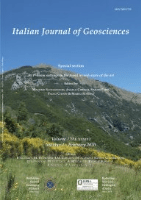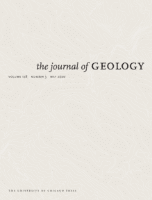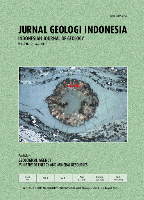
Andean Geology
Scope & Guideline
Exploring Geological Wonders of the Andean Region
Introduction
Aims and Scopes
- Geological Mapping and Remote Sensing:
The journal emphasizes geological mapping and the use of remote sensing technologies, such as ASTER images, to analyze geological features and processes in the Andean region. - Volcanology and Geothermal Studies:
A significant focus on volcanic activity, impacts, and geothermal energy exploration, particularly in relation to the Southern Andes and the associated geological heritage. - Paleontology and Stratigraphy:
Research in this journal often includes paleontological studies and stratigraphic analyses, providing insights into the geological history and evolutionary biology of the region. - Sedimentology and Tectonics:
The journal covers sedimentological studies and tectonic processes, exploring how these factors shape the Andean landscape and influence natural resource distribution. - Geological Heritage and Environmental Implications:
A core area of interest is the assessment of geological heritage sites and their environmental implications, highlighting the intersection of geology and societal impacts.
Trending and Emerging
- Geological Impacts of Climate Change:
There is an increasing focus on how climate change affects geological processes, such as glacier fluctuations and sedimentary dynamics, underscoring the importance of integrating environmental studies with geology. - Interdisciplinary Approaches to Volcanology:
Emerging studies are increasingly interdisciplinary, combining arts, social sciences, and geology to understand the societal impacts of volcanic activity and enhance community resilience. - Sustainable Resource Management:
Research is trending towards the implications of geological studies for sustainable resource management, including energy transition discussions around potential graphite sources and lithium exploration. - Advanced Geochemical and Isotopic Analyses:
There is a growing trend in utilizing advanced geochemical and isotopic techniques for understanding geological history and resource potential, reflecting advancements in analytical methodologies. - Geological Heritage and Conservation:
An increasing emphasis on the assessment and conservation of geological heritage sites is evident, reflecting a broader societal interest in preserving geological features for future generations.
Declining or Waning
- Historical Geological Studies:
There has been a noticeable reduction in publications focusing on historical geological studies, possibly due to a shift towards more contemporary geological issues and applied research. - Traditional Mineral Exploration:
Research centered on traditional mineral exploration methods appears to be waning, as the focus shifts toward more advanced geochemical and geophysical techniques. - Non-Volcanic Geological Phenomena:
Topics related to non-volcanic geological phenomena, such as sedimentary processes unrelated to volcanic activity, have seen a decrease, indicating a growing interest in volcanic and geothermal contexts.
Similar Journals

Austrian Journal of Earth Sciences
Exploring the Depths of Earth SciencesThe Austrian Journal of Earth Sciences, published by SCIENDO, is an esteemed open-access journal specializing in the disciplines of geology, paleontology, and stratigraphy. With an ISSN of 2072-7151, this journal has established itself as a significant platform for innovative research and scholarly communication in the earth sciences. Since its inception in 2007, it has continuously expanded its influence, achieving notable rankings in the Scopus database—#113 in Geology, #42 in Paleontology, and #21 in Stratigraphy, demonstrating its commitment to high-quality publications. The journal holds prestigious quartile rankings of Q1 in both Geology and Paleontology and Q2 in Stratigraphy as of 2023, reflecting its impact and relevance in the scientific community. Researchers and students alike are encouraged to explore and contribute to the evolving discourse within this dynamic field, as the Austrian Journal of Earth Sciences fosters collaboration and knowledge sharing across global platforms.

Italian Journal of Geosciences
Pioneering Discoveries: Shaping the Future of GeosciencesItalian Journal of Geosciences, published by the Società Geologica Italiana, is a distinguished platform for the dissemination of research in the fields of Earth and Planetary Sciences and Geology. With an impressive impact factor reflected in its 2023 rankings, where it placed in the Q3 category across its related fields, this journal serves as a vital resource for academics, practitioners, and students. Established in 2010 and poised to continue until 2024, the journal showcases critical advancements and interdisciplinary studies that deepen our understanding of geological processes and Earth systems. Operating under open access options, it offers robust accessibility to a broad audience, facilitating wider dissemination of knowledge. The journal's affiliation with Università degli Studi La Sapienza in Rome, Italy, further underscores its commitment to academic excellence and innovation in geosciences.

STRATIGRAPHY AND GEOLOGICAL CORRELATION
Charting the Course of Geological DiscoverySTRATIGRAPHY AND GEOLOGICAL CORRELATION is a prominent scholarly journal published by PLEIADES PUBLISHING INC, featuring a dedicated focus on the fields of geology, stratigraphy, and paleontology. With ISSN 0869-5938 and E-ISSN 1555-6263, this journal has been disseminating significant research findings since its inception in 1994, continuously contributing to the academic discourse through 2024. Despite not currently offering open access, its relevance is underscored by its Category Quartiles for 2023, where it has established itself as Q3 in Geology and Paleontology, and Q2 in Stratigraphy. STRATIGRAPHY AND GEOLOGICAL CORRELATION ranks #29 out of 55 in Stratigraphy and #186 out of 321 in Geology according to Scopus metrics, positioning it within the competitive landscape of Earth and Planetary Sciences. Researchers, professionals, and students are invited to engage with the journal’s content to deepen their understanding and foster innovation within these critical areas of study.

Geological Field Trips and Maps
Exploring Earth's Secrets Through Maps and Field StudiesGeological Field Trips and Maps is a pivotal journal published by IST SUPERIORE PROTEZIONE & RICERCA AMBIENTALE-ISPRA in Italy, dedicated to advancing the field of geological sciences through practical applications and systematic exploration. The journal, which operates under the ISSN 2611-6189, focuses on providing valuable insights through geological maps and field trip reports, enriching both academic research and practical understanding of geology. Despite not having an Open Access option, it presents an opportunity for researchers and professionals to engage with peer-reviewed content that navigates through essential topics such as economic geology, stratigraphy, and planetary change, where it holds respectable quartile rankings, including Q3 in Economic Geology and Q4 in Global and Planetary Change as of 2023. Between 2018 and 2024, this journal aims to foster collaboration and knowledge-sharing among geologists, making it an invaluable resource for anyone vested in the exploration of Earth's complex systems.

Geologos
Advancing Earth Science Insights for a Global CommunityGeologos is a peer-reviewed journal dedicated to advancing knowledge in the field of Earth and Planetary Sciences. Published by SCIENDO, this Open Access journal has been facilitating unrestricted access to research findings since 2009, ensuring that scholars, professionals, and students can engage with up-to-date scientific discourse without barriers. With an ISSN of 1426-8981 and an E-ISSN of 2080-6574, Geologos is indexed in Scopus, where it currently holds a rank of #111 out of 195 in the General Earth and Planetary Sciences category, reflecting its commendable impact within the discipline. Based in Poland, the journal embraces contributions from international authors, promoting a diverse and inclusive dialogue on topics ranging from geological phenomena to planetary processes. As a Q3 journal in the Earth and Planetary Sciences category, Geologos is committed to enhancing the understanding and appreciation of the Earth's systems, making it an essential resource for those engaged in research and practice within this dynamic field.

GEOLOGIA CROATICA
Elevating Geological Research for AllGEOLOGIA CROATICA is a distinguished open-access journal published by the Croatian Geological Survey, dedicated to advancing the field of Earth and planetary sciences. Since its inception in 1992, this peer-reviewed journal has become an essential resource for researchers, professionals, and students interested in various aspects of geology. With its robust impact factor and a prestigious place in Scopus rankings, ranking 127th out of 321 in Geology and 77th out of 159 in miscellaneous Earth and Planetary Sciences as of 2023, GEOLOGIA CROATICA maintains a strong international presence. It provides a platform for the dissemination of critical research findings, promoting collaboration and knowledge sharing among the global scientific community. By focusing on high-quality manuscripts that cover geological processes, hazards, and resources, this journal is pivotal for anyone looking to contribute to or expand their understanding of geological sciences. The journal's commitment to open access ensures that invaluable research is accessible to all, fostering a more informed and scientifically engaged society.

JOURNAL OF GEOLOGY
Fostering Dialogue in the Realm of Earth and Planetary Sciences.The JOURNAL OF GEOLOGY, published by University of Chicago Press, serves as a premier platform for disseminating groundbreaking research in the field of geology. Established in 1973, this esteemed journal has consistently ranked in the Q2 category in geology, further solidified by its Scopus ranking, where it is positioned at 99 out of 321 in Earth and Planetary Sciences, marking it in the 69th percentile of its category. With an emphasis on innovative and interdisciplinary studies, the journal features peer-reviewed articles that contribute to the understanding of geological processes, earth materials, and environmental interactions. Although it does not currently offer open access, it facilitates broad access through academic institutions to reach a global audience of researchers, professionals, and students striving to advance the knowledge of Earth's history and dynamics. As a vital resource for the geology community, the JOURNAL OF GEOLOGY plays an essential role in fostering scholarly dialogue and advancing both academic inquiry and practical applications in geology.

ANNALES SOCIETATIS GEOLOGORUM POLONIAE
Exploring the Frontiers of Geology and Stratigraphy.ANNALES SOCIETATIS GEOLOGORUM POLONIAE is a distinguished journal published by the Polish Geological Society, focusing on pivotal research in the fields of geology, economic geology, and stratigraphy. With an ISSN of 0208-9068, this journal has established itself as an essential platform for disseminating significant findings and advancements in geological sciences since its convergence in 2008. The journal proudly holds a Q2 quartile ranking in the categories of Economic Geology, Geology, and Stratigraphy as of 2023, indicating its respectable position within the global academic community. Researchers will find its indexed status in Scopus, ranking #138/321 in Geology and showcasing a solid presence in key geological sub-disciplines. While the journal is not open access, it remains a vital resource for professionals and students striving for insight into contemporary geological research. Located in Krakow, Poland, the journal continues to contribute significantly to the understanding of geological processes and resources, making it an indispensable reference for anyone in the field.

Indonesian Journal of Geoscience
Exploring Earth's Mysteries, One Study at a Time.Indonesian Journal of Geoscience, published by the GEOLOGICAL AGENCY, is a vital platform for sharing cutting-edge research in the field of Earth and Planetary Sciences. With an ISSN of 2355-9314 and E-ISSN of 2355-9306, this open-access journal has been making significant contributions to the geoscientific community since its establishment in 2013. Operating out of Bandung, Indonesia, the journal is dedicated to disseminating high-quality research across diverse areas, making it an essential resource for researchers, professionals, and students alike. Recognized in the 2023 Q2 category in Earth and Planetary Sciences, it currently ranks #134/195 among general Earth and Planetary Sciences journals in Scopus, reflecting its growing prominence and academic rigor. The journal seeks to foster scientific discussions by publishing original research, reviews, and case studies that address contemporary challenges and advancements in geoscience, thus contributing to a deeper understanding of our planet. With its commitment to open access, the Indonesian Journal of Geoscience ensures that vital research is accessible to a global audience, encouraging collaboration and innovation in the field.

JOURNAL OF THE GEOLOGICAL SOCIETY OF INDIA
Unveiling India's geological treasures through research.JOURNAL OF THE GEOLOGICAL SOCIETY OF INDIA, published by Springer India, serves as a pivotal platform for researchers and practitioners in the field of geology. Established in 1979, this journal has been instrumental in advancing geological research throughout India, showcasing both regional studies and cutting-edge global research. With its Category Quartile ranking of Q3 in the geology category for 2023, and a significant Scopus rank of 171 among 321 journals in Earth and Planetary Sciences, it remains a respected source of scholarly activity. The journal is dedicated to the dissemination of original research articles, reviews, and case studies that encapsulate the dynamic scope of geological science, thus contributing to the understanding of geological phenomena. Although currently not offering open access, the journal maintains a commitment to high-quality scholarship and aims to engage a diverse readership, enhancing the knowledge and practice of geology across various disciplines.